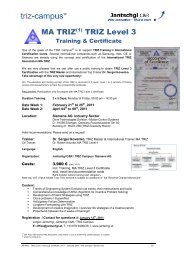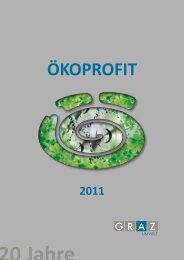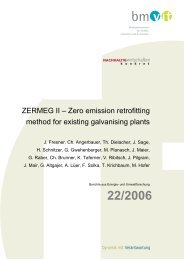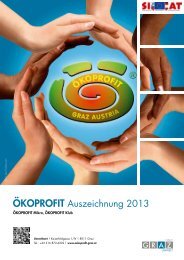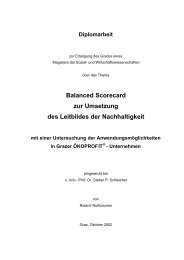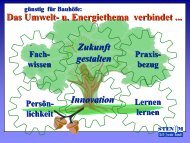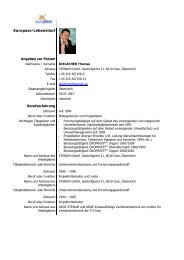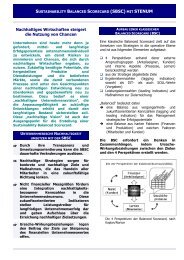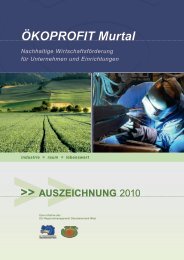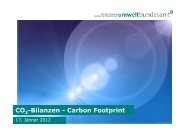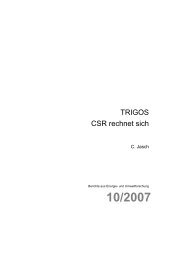Promoting Resource Efficiency in Small & Medium size ... - UNEP
Promoting Resource Efficiency in Small & Medium size ... - UNEP
Promoting Resource Efficiency in Small & Medium size ... - UNEP
Create successful ePaper yourself
Turn your PDF publications into a flip-book with our unique Google optimized e-Paper software.
It <strong>in</strong>ternalises the end-of-life costs and provides a competitive <strong>in</strong>centive<br />
for companies to design equipment that is easy to collect and to recycle.<br />
The Directive also sets goals for recycl<strong>in</strong>g.<br />
The other standards <strong>in</strong> the family cover specific aspects such<br />
as fundamentals and vocabulary, performance improvements,<br />
documentation, tra<strong>in</strong><strong>in</strong>g, and f<strong>in</strong>ancial and economic aspects. 104<br />
10.4 Kyoto protocol<br />
The Kyoto Protocol is a protocol to the United Nations Framework<br />
Convention on Climate Change (UNFCCC or FCCC). It aims at tak<strong>in</strong>g<br />
global action aga<strong>in</strong>st global warm<strong>in</strong>g. The Protocol was adopted on<br />
11 December 1997 <strong>in</strong> Kyoto. As of October 2009, 184 states have<br />
signed and ratified the protocol (not the United States). Under the<br />
Protocol, 37 <strong>in</strong>dustrialised countries agreed to reduce their collective<br />
greenhouse gas emissions by 5.2% tak<strong>in</strong>g the 1990 level as a<br />
reference. Emissions from <strong>in</strong>ternational aviation and shipp<strong>in</strong>g are not<br />
<strong>in</strong>cluded <strong>in</strong> the protocol.<br />
The so-called Clean Development Mechanism (CDM) allows for<br />
partnerships between develop<strong>in</strong>g and <strong>in</strong>dustrialised countries 103 .<br />
Under the CDM, a develop<strong>in</strong>g country can implement emission<br />
reductions projects that can be traded or sold to <strong>in</strong>dustrialised<br />
countries as certified emission reduction (CER) credits.<br />
The CDM is supervised by the CDM Executive Board (CDM EB) under<br />
the guidance of the Conference of the Parties (COP/MOP) of the United<br />
Nations Framework Convention on Climate Change (UNFCCC).<br />
10.6 ISO 14001<br />
The ISO 14000 family addresses various aspects of environmental<br />
management. The first two standards, ISO 14001:2004 and ISO<br />
14004:2004 deal with environmental management systems (EMS). ISO<br />
14001:2004 provides the requirements for an EMS and ISO 14004:2004<br />
gives general EMS guidel<strong>in</strong>es.<br />
The other standards and guidel<strong>in</strong>es <strong>in</strong> the family address specific<br />
environmental aspects, <strong>in</strong>clud<strong>in</strong>g: labell<strong>in</strong>g, performance evaluation,<br />
life cycle analysis, communication and audit<strong>in</strong>g.<br />
An EMS meet<strong>in</strong>g the requirements of ISO 14001:2004 is a management<br />
tool enabl<strong>in</strong>g an organisation of any <strong>size</strong> or type to:<br />
• Identify and control the environmental impact of its activities,<br />
products or services<br />
• Improve its environmental performance cont<strong>in</strong>ually<br />
• Implement a systematic approach to sett<strong>in</strong>g environmental<br />
objectives and targets, to achiev<strong>in</strong>g these and to demonstrat<strong>in</strong>g that<br />
they have been achieved 105<br />
10.5 ISO 9001<br />
The ISO 9000 family of standards represents an <strong>in</strong>ternational consensus<br />
on good quality management practices. It consists of standards<br />
and guidel<strong>in</strong>es relat<strong>in</strong>g to quality management systems and related<br />
support<strong>in</strong>g standards.<br />
ISO 9001:2008 provides a set of standardised requirements for a quality<br />
management system, regardless of what the user organisation does, its<br />
<strong>size</strong>, or whether it is <strong>in</strong> the private or public sector. It is the only standard<br />
<strong>in</strong> the family aga<strong>in</strong>st which organisations can be certified – although<br />
certification is not a compulsory requirement of the standard.<br />
10.7 OHSAS 18000<br />
OHSAS 18001 has been developed to be compatible with the ISO<br />
9001 (Quality) and ISO 14001 (Environmental) management systems<br />
standards, <strong>in</strong> order to facilitate the <strong>in</strong>tegration of quality, environmental<br />
and occupational health and safety management systems by<br />
organisations, should they wish to do so.<br />
The (OHSAS) specification gives requirements for an occupational<br />
health and safety (OH&S) management system, to enable an<br />
organisation to control its OH&S risks and improve its performance.<br />
It does not state specific OH&S performance criteria, nor does it give<br />
detailed specifications for the design of a management system. 106<br />
103) UNFCCC, Kyoto Protocol, undated<br />
104) ISO – International Standard Organisation, ISO 9000 essentials, 2008<br />
105) ISO – International Standard Organisation, ISO 14000 essentials, 2004<br />
106) OHSAS 18001 HEALTH & SAFETY STANDARD, The Health and Safety & OHSAS Guide, undated<br />
104



